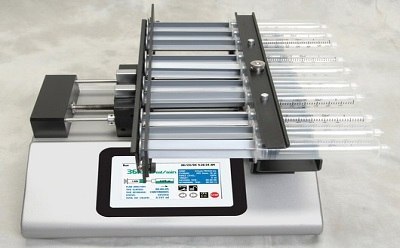Laboratory Pumps

Lab pumps are devices used for fluid transfer and metering. They are designed to precisely control the fluid flow rates in many applications such as chromatography, sample preparation, and reagent dispensing. Several types of lab pumps are available, including peristaltic pumps, syringe pumps, piston pumps, and diaphragm pumps. The choice of the pump will depend on the specific application and the requirements of the experiment.
Vacuum Pumps
Lab vacuum pumps are used in scientific research and analytical testing to create and maintain a vacuum in laboratory equipment such as distillation apparatus, vacuum ovens, rotary evaporators, vacuum filtration, vacuum aspiration, gel drying, blotting, and freeze-drying. Lab vacuum pumps can be divided into two main categories: oil-sealed pumps and oil-free pumps. Oil-sealed pumps, such as rotary vane pumps, use oil as a lubricant and sealing fluid. Oil-free pumps, such as diaphragm pumps and scroll pumps, do not require oil and are sometimes preferred for applications where oil contamination is a concern, such as in vacuum drying of samples or in mass spectrometry.
Vacuubrand Vacuum Pumps
Vacuubrand diaphragm vacuum pumps are used for continuous, oil-free pumping of gases and vapors. These pumps offer high pumping speed and exceptionally low ultimate vacuum. They are available in standard models for non-corrosive materials and chemical-resistant options, providing high resistance to corrosive gases and vapors.
Vacuubrand rotary vane vacuum pumps are powerful and compactable, allowing them to achieve an excellent ultimate vacuum. They feature optimized lubrication circulation to maximize the time between maintenance and oil checks.
Milliflex Oasis® Filtration Pumps
Milliflex Oasis® pumps are used in water and bioburden analysis in pharmaceutical environments.
Aspirator Pumps
Laboratory aspirator pumps are basic tools commonly used in biological laboratories. They are utilized to suction residual liquids after various experiments, including waste from the cell culture medium, supernatant after centrifugation in a centrifugal tube, residual liquids in a 96-well plate, and more. These pumps also serve as a safe collection system to deal with critical liquids, dangerous pathogens, and waste classified as class III or IV biological hazards. The principle of the laboratory aspirator is to create a negative pressure state in the aspirator head, causing atmospheric pressure to draw the material from outside the head into the aspirator apparatus through extrusion, thus achieving the aspiration effect.
ASPIRE™ Vacuum Aspirator
The ASPIRE Laboratory Aspirator incorporates a quiet, maintenance-free pump inside a sturdy, yet compact base. The vacuum is fully adjustable, with a pressure gauge that displays the vacuum level, allowing full control of aspirating speed. The ASPIRE is an ideal choice for a wide range of laboratory aspirating applications, including removal of media from tissue culture vessels or plates, and supernatants.
Water Aspirators
Also known as a faucet aspirator, these traditional vacuum-creating devices are attached to a faucet in a sink and use the Venturi effect to create a vacuum as cold water runs down its length. Various versions are available: Standard polyethylene tubing designs both with and without reducing adaptors, as well as Chapman swirling ball-type designs with a positive-acting valve in the suction tube to prevent backflow in case pressure is reduced.
Peristaltic Pumps
Peristaltic pumps, also commonly known as roller pumps, are a type of positive displacement pump that uses rotating rollers to compress and decompress a flexible tube or hose to move fluids. The rollers create a series of pressure waves that move the fluid through the tube without any contact between the fluid and the pump components. This design makes peristaltic pumps ideal for moving fluids that are sensitive to contamination, as well as corrosive, abrasive, or viscous fluids.
Multiflow Peristaltic Pumps
Multiflow peristaltic pumps are used in various applications, including fermentation, bio cultures, chemical synthesis, and fraction collection. These pumps enable the programming of flow rate with up to 99 steps. Additionally, by programming zero flow rates, the pump can be easily switched on and off without using a timer.
Preciflow Peristaltic Pumps
Traditional peristaltic pumps often lead to interruptions in processes due to decreasing flow rates, tubing aspiration, or mechanical rupture, resulting in both time and financial losses. Addressing these issues, the Preciflow peristaltic pump emerged from 20 years of lab experience, systematically rectifying the flaws present in other pumps. The outcome is an exceptional, compact, and reliable pump, embodying practicality, precision, and cost-effectiveness.
Syringe Pumps
Syringe pumps are a type of positive displacement pump that uses a syringe to move fluids. The syringe is attached to a motor, which moves a plunger to push or pull fluid through a tubing or needle attached to the end of the syringe. This design allows for precise control over the flow rate and volume of the fluid being dispensed, making syringe pumps ideal for laboratory and medical applications where accurate dosing is required. They are commonly used for calibration, drug delivery, dilution, dispensing, dosing, emulsifying, infusion/withdrawal applications, microfluidics research, and high-performance liquid chromatography (HPLC).
KDS Syringe Pumps
KD Scientific syringe pumps provide liquid handling for automated and affordable delivery of fluids and gas in the laboratory environment. Recognized worldwide for quality and reliability at an economical price, KD Scientific has the broadest line of economical infusion pumps, syringe pumps, and syringe pumps with infuse and withdraw capability.
Drum Pumps
Drum pumps are devices used to transfer liquids from large containers such as drums into smaller containers. In a laboratory setting, drum pumps can be used to dispense chemicals and other liquids from large storage drums into smaller vessels for use in experiments or analysis. These pumps are designed for the safe and efficient transfer of liquids and typically consist of a motorized pump head, a hose or tube for liquid transfer, and a nozzle or spout for dispensing the liquids.
Metal Drum Pumps
These pumps are made of carbon steel and consist of PTFE pump with grounding wires and clamps. They are used for dispensing solvents and non-corrosive liquids.
To continue reading please sign in or create an account.
Don't Have An Account?